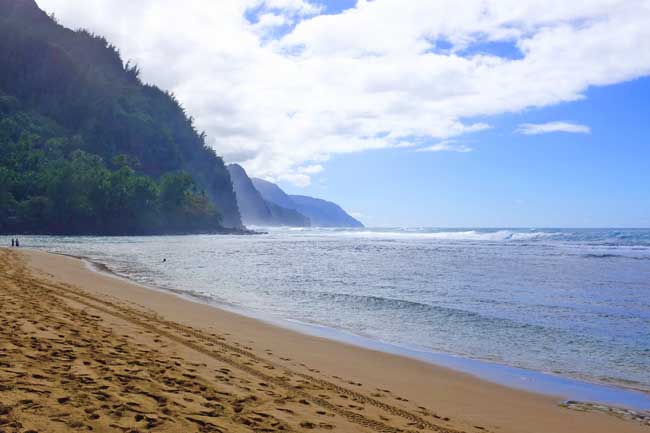

The Kalalau Trail in Kauai is infamous for its 11 miles of twisting, muddy track that crosses swollen streams and vertiginous cliffs.
A Hawaiian rite of passage for the brave and the fit, there’s always a risk of falling to your doom if the fluting slivers of rock that make up the Na Pali cliffs give way.
But now I know; the Kalalau Trail is for wimps. Real women swim the route, in the pounding sea right below.
Swimming the Kalalau Trail
I was nervous even before I got to Ke’e beach, where the North Shore road finally peters out into a series of potholes.
I swim a couple of times a week for a lackadaisical half hour; this was a swim of a different order altogether.
The 20 or so people on the beach looked buff, young and lean. They were in surf bikinis and shorts.
I made quite an entrance as the only participant wearing a neon (glow-in-the-dark-and-apparently-also-the-day) inflatable life jacket. They eyed me with curiosity and turned back to the water.
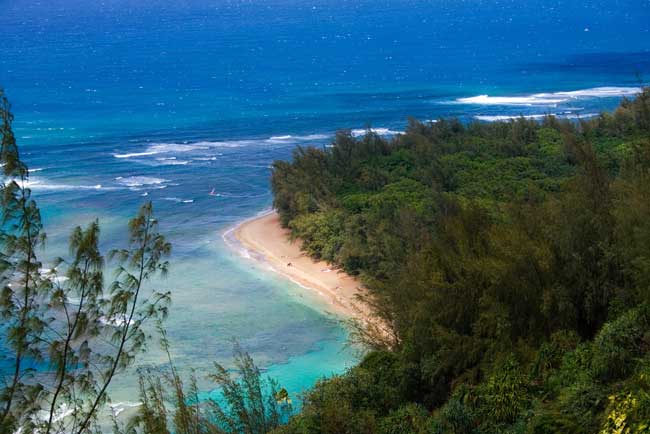
There were a few things going for me. The sea was relatively calm for the end of summer; we weren’t doing the whole trail, just the first part to Hanakapiʻai Beach.
I had a mask and fins, which takes a lot of the effort out of swimming.
As a loose group brought together by the power of Facebook, we’d also be counted into the water and out again. So in theory, someone would notice if I drowned.
About the Panic Attack
There was a brief muster, where the organizer talked about people having panic attacks and explained how difficult that was to deal with in the water. I felt panicky already.
He looked around the crowd and asked if anyone felt panicky. I shrank a little further into the back row as his eyes were drawn to my bright jacket. And then the crowd was off, whooping and splashing into the water.
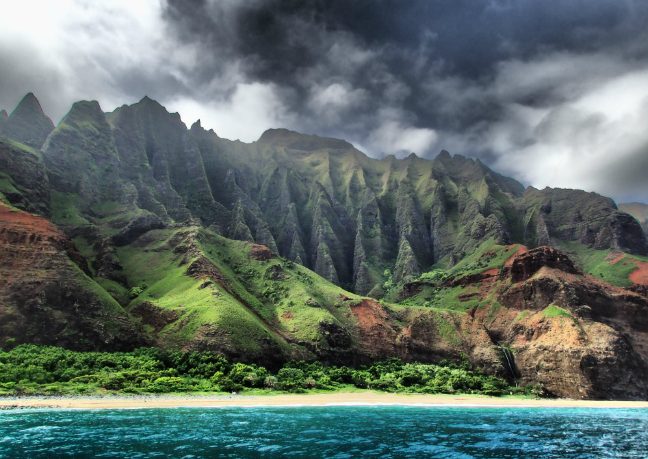
Ke’e Beach
What I know now, is that getting out of Ke’e Beach is the worst part of the whole swim (getting into Hanakapiʻai is the second worst part, but we’ll come to that later).
The water is choppy over the reef, and you have to look up a lot to see where you’re going. Gallons of brine seem to pour down your snorkel every other breath.
As I struggled past the surf and through the white caps, the rolling sensation of the sea was amplified as the waves bounced off the tall, shadowy Na Pali cliffs.
Face down in the water, the ink spot of nausea in my chest spread into a nasty stain.
Swimming Against the Current
With a powerful taste of salt in my mouth, I flailed along, anxiously wondering if I was at the back and interrogating my limbs to keep going. I was already gasping for breath. And then I caught the current.
It was fast. Slowly it dawned on me that even if I stopped swimming completely, I would drift, like a bioluminescent piece of human flotsam, in roughly the right direction, buoyed up by the salt water.
With a relatively lazy front crawl, even one inconvenienced by the ludicrous jacket, I was Michael Phelps on an ocean conveyor belt. I put my head down, kicked off and began to enjoy the show.
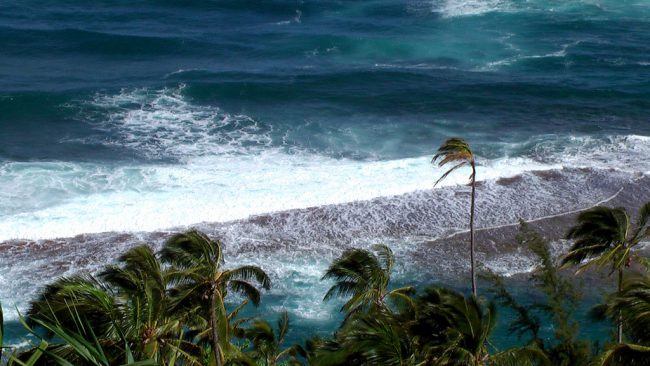
Tiny particles of sand were suspended in the sea, catching the light as they slowly sank, like aquatic snow. Even in the shade of the undulating cliffs, the water was warm.
I was happily alone between two straggling groups of swimmers, catching the occasional glimpse of their sleek heads in front.
Icy fear receded to a few small crystals in my belly. My perspective of the Na Pali cliffs from the ocean began to add to their beauty.
In less than half an hour, I saw the first swimmers begin to turn toward the shore, aiming for a cove accessible only from the water.
As I got closer, hundreds of Brown Noddy birds, angry at the intrusion into their breeding grounds, swirled elegantly around my head, staying just above the sea spray in the cool morning air.
I crashed through the surf and was tossed by a wave onto the volcanic sand in front of a huge cavern.
A curtain of cold fresh water rained down, percolating from the cliff overhead. With everyone pumped up on endorphins and excitement, it felt like we were discovering a new continent.
The girls threw themselves into handstands against the ancient lava cave walls and we leapt from crumbling sandbanks back into the surf.
Just as we set off again, two Spotted Eagle Rays appeared in the curl of a wave, perfectly silhouetted for a few seconds, before the crest crashed down.
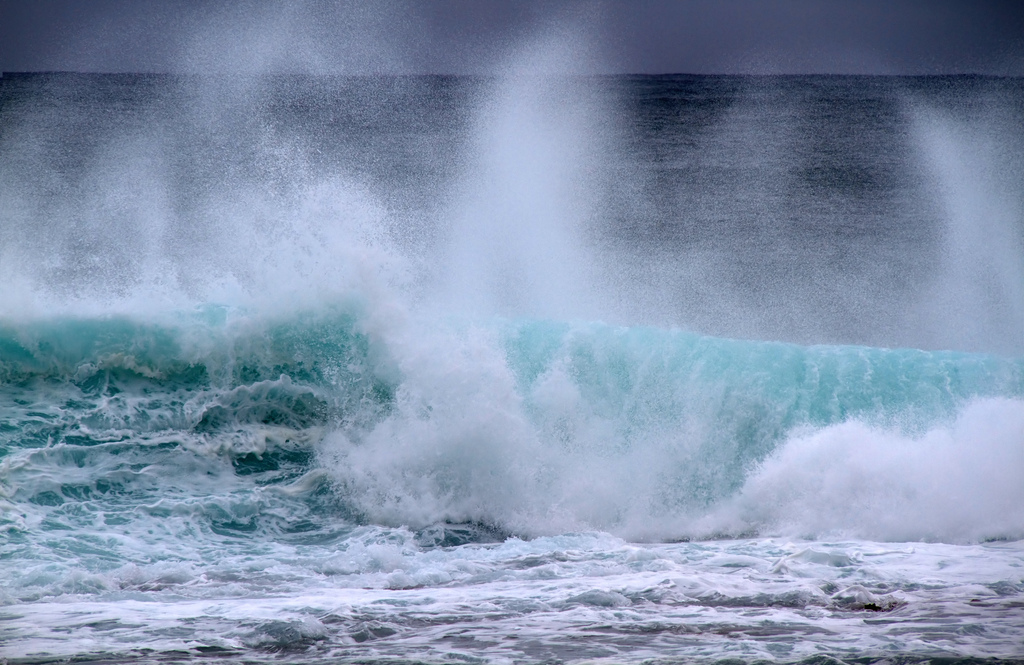
Hanakapiʻai Beach
Our next stop was Hanakapiʻai Beach and it is a killer. More than 30 people have died here since 1970. The surf is high and there can be a vicious current that sucks out tourists, already tired from their hike.
I made it out of the water between two large sets of surf but other swimmers got knocked about by the waves; a lone fin had to be rescued after it was sucked right off a foot.
As we struggled onto dry land, hikers gaped at us from the sand. They are advised not to swim here and with good reason.
You need to be familiar with the currents and weather before you attempt this kind of entrance, or at least swim with others who are.
Out of the water, we got chilly quickly, so holding our fins and masks, we set off back along the slick, red mud trail in bare feet or diving booties, feeling slightly exposed in our wet swimming gear.
We got some funny looks from the people we passed; the trail is famous for its barefoot hippies who live in the valley and commute back to civilization for supplies.
Most people were slack-jawed at the idea of us swimming the same route that they had just taken two hours or more to walk.
For the first half a dozen people, I explained about the current and the fins and the Olympic swimmer fantasy. But after that, I began to simply nod sagely.
It’s OK to let people think you are Superwoman once in a while. Kauai is, after all, a rather fantastical island.
If You Go to Kauai:
- The Island of Kauai is the most northerly in the Hawaiian chain. There are direct flights from Lihue to North America with several carriers including Hawaiian Airlines, United and American Airlines.
- Find the Sunday Morning Summer Swims Group on Facebook at facebook.com/groups/258918590977399. The swims are seasonal, and the group mainly attempts the Hanakapiʻai Beach swim in the summer.
- For more information on Kauaʻi, try https://www.gohawaii.com/islands/kauai or https://www.kauaiexplorer.com/
Author Bio: Helen Raine is a conservationist and writer based in Hawaii. She has undertaken fieldwork in England, Malta, Peru, Zambia, New Zealand and Hawaii, often living for months in a tent. Her adventures in bird ringing and conservation continue to take her round the world. As a freelance journalist, she writes on a diverse range of subjects and has published hundreds of articles for publications such as the Times of Malta, Il-Bizzilla (Air Malta’s inflight magazine), FijiTime and Pink, a woman’s magazine. Helen is also a content writer for websites.
- How to Plan Your Dream African Safari - July 18, 2025
- How to Visit Hawaii Responsibly: 10 Low-Impact Travel Tips - July 17, 2025
- Samaná: The Dominican Republic’s Lush Peninsula Where Silence Is Golden and So Is the Sand - July 17, 2025
